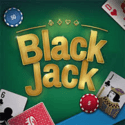Ultimate Guide to Online Blackjack
Blackjack is the king of casino card games, blending simple rules with deep strategy. Our guide will teach you the objective, the rules, and the core strategies you need to lower the house edge and play with confidence.

The Objective of Blackjack
The goal of blackjack is simple: create a hand with a total value higher than the dealer's hand, without going over 21. If your hand value exceeds 21, you "bust" and automatically lose the round.
Card Values
- Cards 2-10: Are worth their face value.
- Face Cards (King, Queen, Jack): Are each worth 10.
- Ace: Is worth either 1 or 11, whichever is more beneficial for your hand. This makes it a powerful and flexible card.
The History of Blackjack
Blackjack's origins trace back to 1700s France and a game called "Vingt-et-Un" (Twenty-One). It became popular in French casinos and eventually made its way to America with colonists. To promote the game, US gambling halls offered special bonus payouts, including one that paid extra if a player's hand consisted of an Ace of Spades and a black Jack (Spades or Clubs). This "black jack" hand gave the game its modern name, and even though the bonus payout was eventually phased out, the name stuck.
When did blackjack appear at online casinos?
Blackjack was a cornerstone of the very first online casinos that launched in the mid-1990s. As one of the most popular casino games in the world, it was essential for the pioneering software developers like Microgaming to include it in their initial game libraries. These first online blackjack games were simple, RNG-based versions, but they successfully translated the core gameplay to the digital world and have been a staple for online players ever since.
Blackjack Variations: American vs. European
While there are many variants, most online blackjack games are based on two main sets of rules.
American Blackjack
In the American version, the dealer receives two cards at the start of the round: one face up and one face down (the "hole card"). The dealer can "peek" at their hole card if the upcard is an Ace or a 10-value card. If the dealer has a natural blackjack, the round ends immediately, saving players from making additional losing bets (like doubling down).
European Blackjack
In the European version, the dealer only receives one card face up. They do not receive their second card until after all players have finished playing their hands. This means players might double down or split their hand, only to lose their increased bet to a dealer's natural blackjack. This subtle difference slightly increases the house edge compared to the American version.
Live Dealer Blackjack
Live Dealer Blackjack offers the most authentic online experience. You play with a real human dealer, using physical cards, all streamed to your device in real-time. You can interact with the dealer and other players, combining the convenience of online play with the social atmosphere of a land-based casino.
Key Strategies and Player Decisions
Unlike games of pure chance, your decisions in blackjack matter. Knowing when to make the right move is crucial.
- Hit: Request another card. You should generally hit if your hand total is low (e.g., 11 or less) or if you have a hand like 12-16 and the dealer is showing a strong card (7 or higher).
- Stand: Take no more cards. You should generally stand on high totals (Hard 17 or more) or if your hand is 13-16 and the dealer has a weak card (2-6), hoping they will bust.
- Double Down: Double your initial bet in exchange for receiving only one more card. This is a powerful move when you have a strong starting hand, like a total of 11, or a 10 against a weak dealer card.
- Split: If your first two cards are a pair (e.g., two 8s or two Aces), you can split them into two separate hands, placing an additional bet equal to your first. You should always split Aces and 8s.
- Insurance: If the dealer's upcard is an Ace, you'll be offered an "insurance" side bet. This is a bet that the dealer has blackjack, and it pays 2:1. Statistically, insurance is a bad bet for the player and increases the house edge. It's almost always best to decline it.
Card Counting and RTP
Can You Count Cards Online?
Card counting is a strategy used to track the ratio of high-to-low cards left in the deck to determine when the odds are in the player's favor. While it is legal, casinos reserve the right to remove players they suspect of counting. However, in standard online blackjack, card counting is ineffective. The games use a Random Number Generator (RNG) and the virtual "deck" is reshuffled after every single hand, making it impossible to track cards.
RTP and House Edge
Blackjack has one of the lowest house edges of any casino game, meaning it has a very high Return to Player (RTP). With perfect basic strategy, the RTP can be as high as 99.5%. However, small rule variations can change this:
- Blackjack Payouts: A game that pays 3:2 for a natural blackjack is standard. Avoid games that pay 6:5, as this significantly increases the house edge.
- Dealer Stands on Soft 17: It is more favorable to the player if the rules state the dealer must stand on all 17s.
- Number of Decks: Fewer decks are generally better for the player. A single-deck game has a lower house edge than an 8-deck game.
